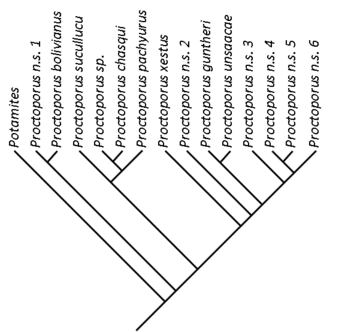Proctoporus
Proctoporus is a genus of medium-sized lizards (between 2.7 centimetres or 1.1 inches and 7.8 centimetres or 3.1 inches) assigned to the family Gymnophthalmidae. Species in the genus Proctoporus occur in yungas forests and wet montane grasslands on the upper edge of the Amazonian forest, between 1,000 and 4,000 metres (3,300 and 13,100 ft) elevation, from Central Peru in the north to Central Bolivia in the south.[1]
| Proctoporus | |
|---|---|
| Scientific classification | |
| Kingdom: | Animalia |
| Phylum: | Chordata |
| Class: | Reptilia |
| Order: | Squamata |
| Family: | Gymnophthalmidae |
| Tribe: | Cercosaurini |
| Genus: | Proctoporus Tschudi, 1845 |
| Synonyms | |
|
Opipeuter Uzzell, 1969, non Fortey, 1974 (a trilobite) | |
Taxonomy

Relationships between the species assigned to Proctoporus. Note several new species that were previously assigned to P. bolivianus, but need to be split-off based on genetic analysis
Species
The following 17 species are recognized as being valid.[2]
- Proctoporus bolivianus F. Werner, 1910 – Bolivian lightbulb lizard
- Proctoporus carabaya Goicoechea, Padial, Chaparro, Castroviejo-Fisher & De la Riva, 2013
- Proctoporus cephalolineatus García-Pérz & Yustiz, 1995
- Proctoporus chasqui (Chávez, Siu-Ting, Duran & Venegas, 2011)
- Proctoporus guentheri (Boettger, 1891) – Günther's lightbulb lizard
- Proctoporus iridescens Goicoechea, Padial, Chaparro, Castroviejo-Fisher & De la Riva, 2013
- Proctoporus kiziriani Goicoechea, Padial, Chaparro, Castroviejo-Fisher & De la Riva, 2013
- Proctoporus lacertus (Stejneger, 1913)
- Proctoporus laudahnae (G. Köhler & Lehr, 2004)
- Proctoporus machupicchu Mamani, Goicoechea & Chaparro, 2015 – Machu Picchu Andean lizard
- Proctoporus oreades Chávez, Siu-Ting, Duran & Venegas, 2011
- Proctoporus pachyurus Tschudi, 1845 - Tschudi's lightbulb lizard
- Proctoporus rahmi (De Grijs, 1936) - Rahm's sun tegu
- Proctoporus spinalis (Boulenger, 1911) - Boulenger's sun tegu
- Proctoporus sucullucu Doan & Castoe, 2003
- Proctoporus unsaacae Doan & Castoe, 2003
- Proctoporus xestus (Uzzell, 1969) - river teiid
Nota bene: A binomial authority in parentheses indicates that the species was originally described in a genus other than Proctoporus.
gollark: We are all CONFUSION.
gollark: It seems as if there is not.
gollark: The question is, is there conservation of poetry badness?
gollark: Bad poetry.
gollark: The sun is basically just a giant high-powered gravitational confinement fusion reactor with built-in wide-spectrum power beaming capability.
References
- Goicoechea N, Padial JM, Chaparro JC, Castroviejo-Fisher S, De la Riva I (2012). "Molecular phylogenetics, species diversity, and biogeography of the Andean lizards of the genus Proctoporus (Squamata: Gymnophthalmidae)". Molecular Phylogenetics and Evolution. 65 (3): 953–964. doi:10.1016/j.ympev.2012.08.017. PMID 22982151.
- Genus Proctoporus at The Reptile Database. www.reptile-database.org.
Further reading
- Tschudi JJ de (1845). "Reptilium conspectus quae in Republica Peruana reperiuntur et pleraque observata vel collecta sunt in itinere ". Archiv für Naturgeschichte 11 (1): 150–170. (Proctoporus, new genus, p. 161; P. pachyurus, new species, p. 161). (in Latin).
This article is issued from Wikipedia. The text is licensed under Creative Commons - Attribution - Sharealike. Additional terms may apply for the media files.